Remember when bathrooms weren’t just functional spaces but statements of personality and style?
The charm of retro bathrooms is making a major comeback, combining vintage aesthetics with modern functionality.
✨Click to Get My 101 FREE Designer Room Ideas
Candy-Colored Pastel Paradise
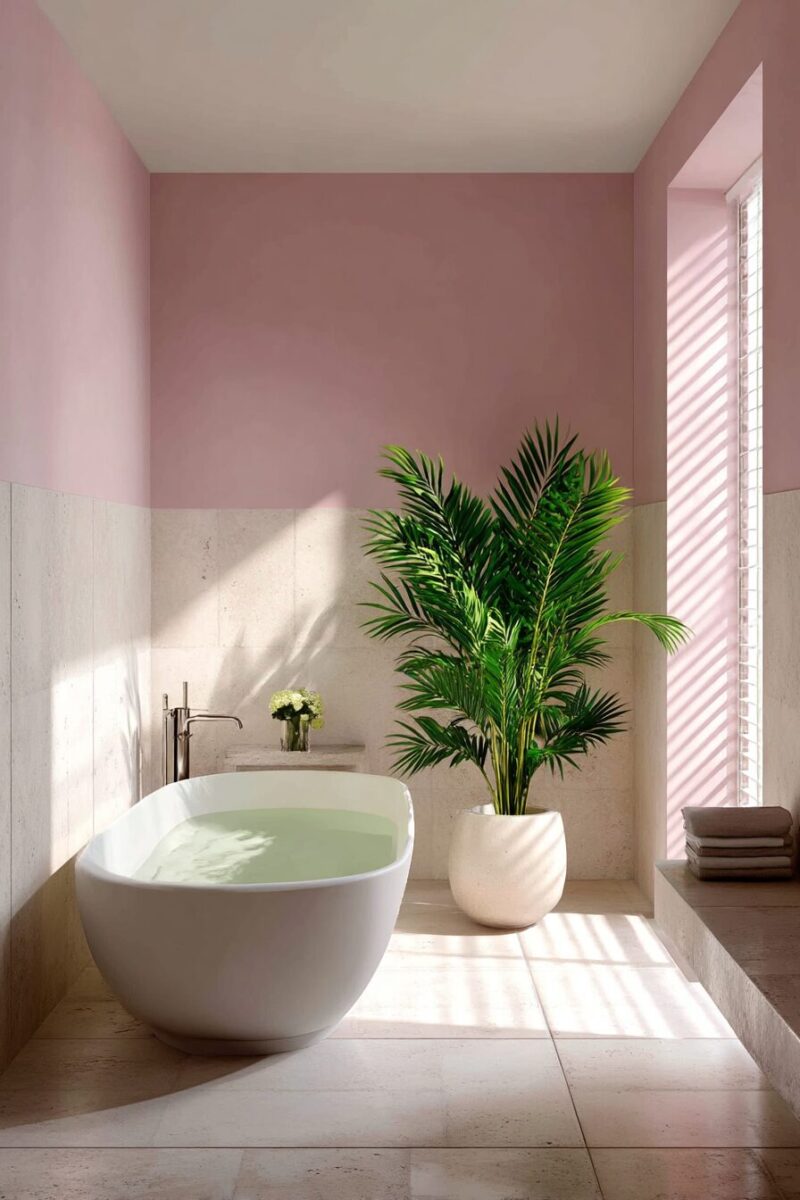
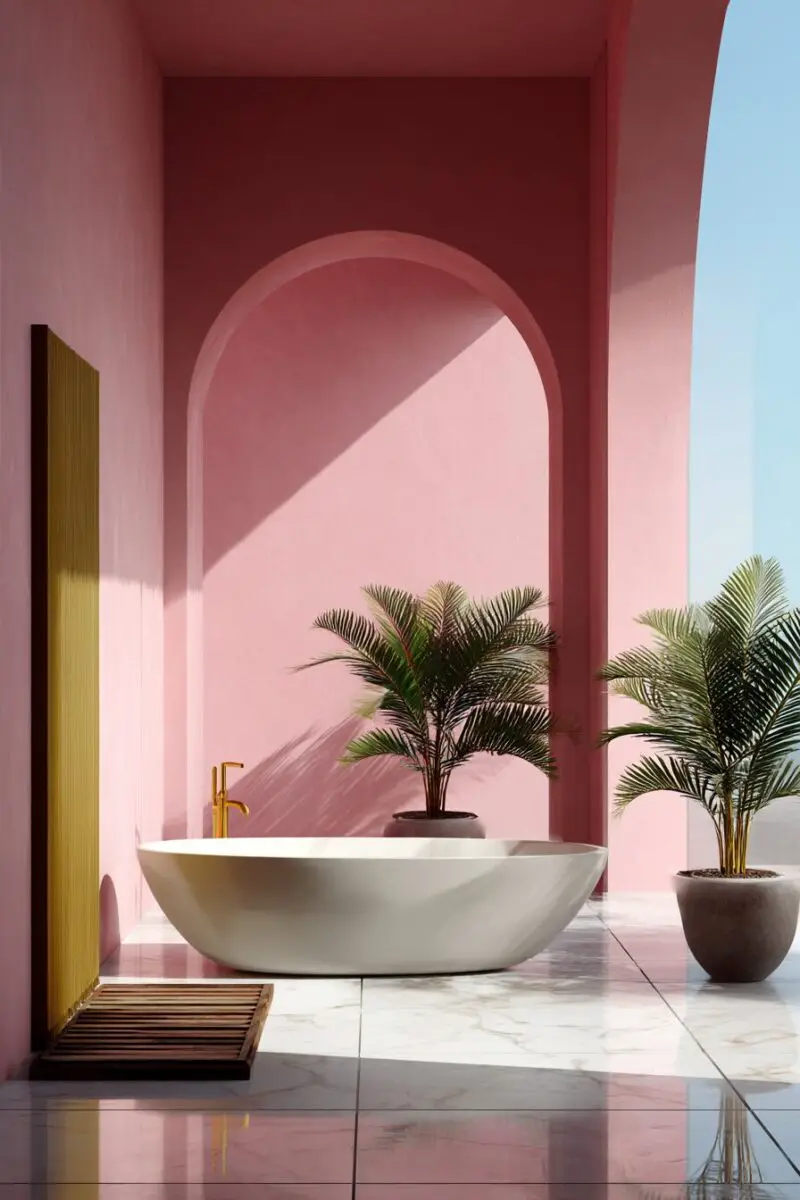
Nothing screams retro quite like those iconic 1950s pastel bathrooms that your grandparents probably had (and secretly loved).
The most popular colors were mint green, baby blue, sunset pink, and buttery yellow – often paired with black accents for dramatic contrast.
You can go all-in with colored ceramic tile from floor to ceiling for an authentic look, or just introduce the color through painted walls if you’re not ready to commit fully.
The beauty of pastel bathrooms lies in their unexpected cheerfulness – who wouldn’t want to start their day surrounded by happy hues?
Matching your fixtures to your chosen pastel theme can create a cohesive look that feels intentional rather than outdated.
Modern manufacturers now offer vintage-inspired toilets, sinks and tubs in these classic colors, saving you the trouble of hunting down (and restoring) authentic pieces.
The key to making pastel work is balancing it with white elements to prevent the space from feeling overwhelmed by color.
Adding chrome or brass fixtures provides the perfect metallic pop against soft pastel backgrounds.
For a truly authentic touch, look for vintage pastel soap dishes, toothbrush holders, and other accessories at flea markets or online vintage stores.
Remember that lighting is crucial in pastel bathrooms – opt for warm-toned bulbs rather than cool LEDs to enhance the cozy, nostalgic feeling.
The pastel trend works particularly well in smaller bathrooms, where the light colors can help the space feel larger and more open.
Bonus tip: if you find original pastel fixtures in good condition while house hunting, consider yourself lucky – preservationists and retro enthusiasts pay top dollar for these colorful pieces.
Checkered Floors That Make a Statement
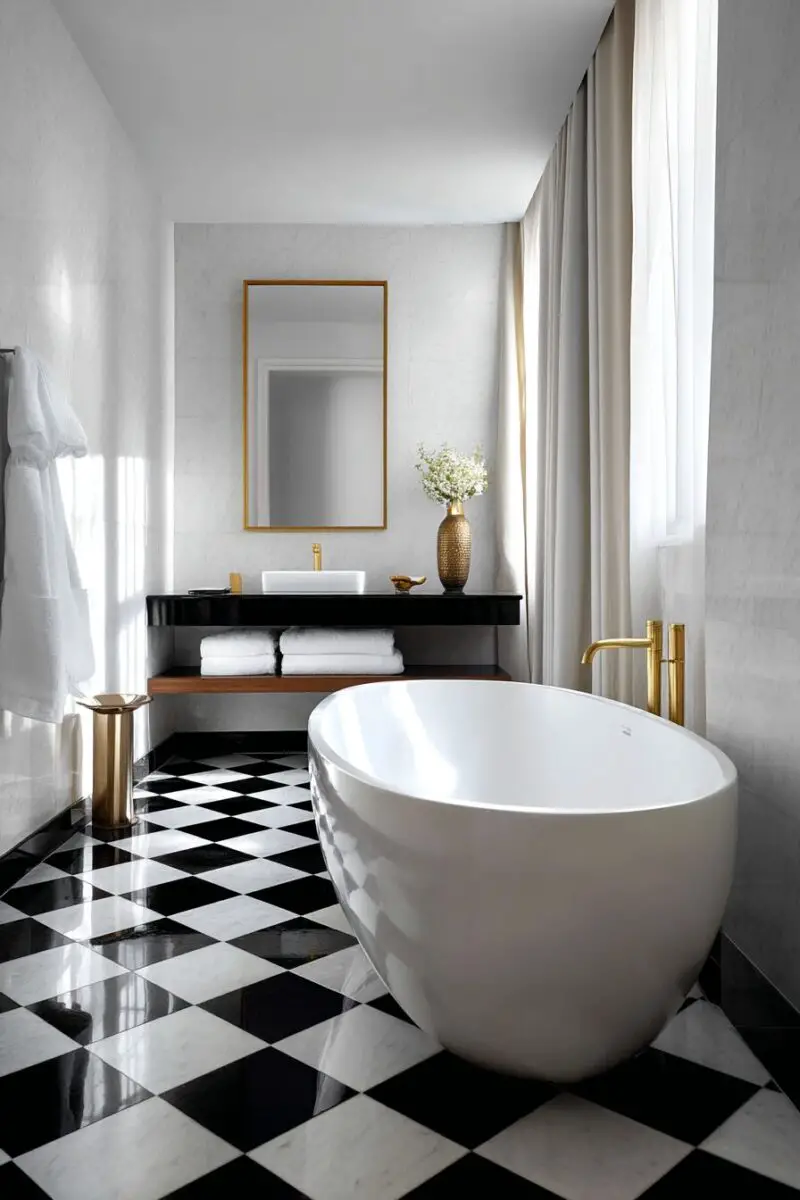
That iconic black and white checkerboard tile floor isn’t just classic – it’s practically the unofficial symbol of retro bathroom design.
This high-contrast pattern immediately establishes vintage vibes while somehow remaining eternally modern.
You can go traditional with standard-sized square tiles, or mix things up with hexagonal versions for a fresh twist on this classic look.
The beauty of checkerboard is its versatility – it works with virtually any color scheme or bathroom style, from 1920s Art Deco to 1950s sock hop.
While black and white is the classic combo, don’t be afraid to experiment with other color pairings like navy and white or even pink and black for a unique spin.
The pattern creates an optical illusion that can make your space appear larger, making it perfect for smaller bathrooms.
Modern porcelain tiles are more durable and easier to maintain than the original ceramic versions, while still capturing that authentic look.
For extra visual interest, consider laying the tiles on a diagonal rather than straight on – this unexpected angle adds drama and can make a narrow bathroom appear wider.
Pairing checkerboard floors with white subway tile walls creates a timeless combination that never goes out of style.
The high-contrast pattern also helps disguise the inevitable bathroom dust and hair that shows up so prominently on solid-colored floors.
For a budget-friendly alternative, look into vinyl checkerboard flooring that captures the look without the installation headache of individual tiles.
Remember that grout color makes a huge difference – white grout between black and white tiles creates a crisp, clean look, while gray or black grout adds vintage authenticity.
The pattern works equally well in large format tiles for a bold statement or tiny mosaics for a more delicate, refined look.
Clawfoot Tubs: The Crown Jewel of Retro Bathrooms
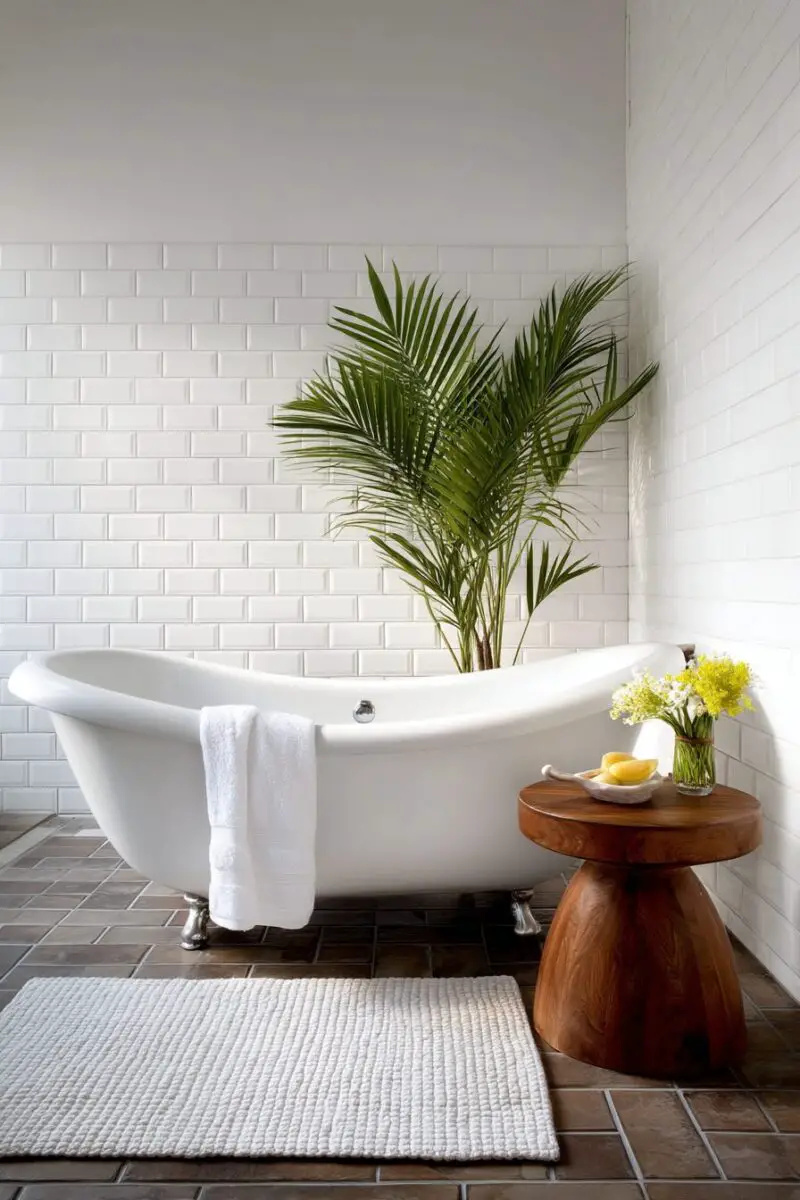
Nothing says luxury quite like a freestanding clawfoot tub commanding attention in the center of your bathroom.
These iconic tubs date back to the Victorian era but enjoyed massive popularity in the early 20th century before built-in tubs became the norm.
You can find authentic vintage clawfoot tubs that have been professionally refinished, or choose from many new reproductions that offer the same aesthetic with modern conveniences.
The classic white porcelain interior paired with ornate feet (usually in a metallic finish) creates an instant focal point that elevates any bathroom’s style factor.
Beyond the standard white exterior, consider painting the outside of your tub a bold color like deep navy, emerald green, or even matte black for a contemporary twist on this retro favorite.
The ergonomic shape of these tubs – sloped at one end and more vertical at the other – was actually designed for optimal soaking comfort, proving that sometimes older designs really are better.
Installing a clawfoot requires some planning since the plumbing is exposed rather than hidden behind walls – but this visibility becomes part of the vintage charm.
You’ll need to pair your tub with a specialized shower conversion kit if you want the option to stand and shower.
The elevated design of clawfoot tubs makes cleaning underneath easier than with standard built-ins.
Most clawfoot tubs are deeper than modern built-in versions, allowing for a more luxurious, full-immersion bathing experience.
The weight of these cast iron beauties (often 300-400 pounds) means you’ll need to ensure your bathroom floor can support the load before installation.
For smaller bathrooms, look for slipper tubs (higher on one end) or shorter models that deliver the same visual impact in a more compact footprint.
The timeless appeal of clawfoot tubs means they never really go out of style, making them an investment that will continue looking relevant through changing bathroom trends.
Vintage Vanities with Character
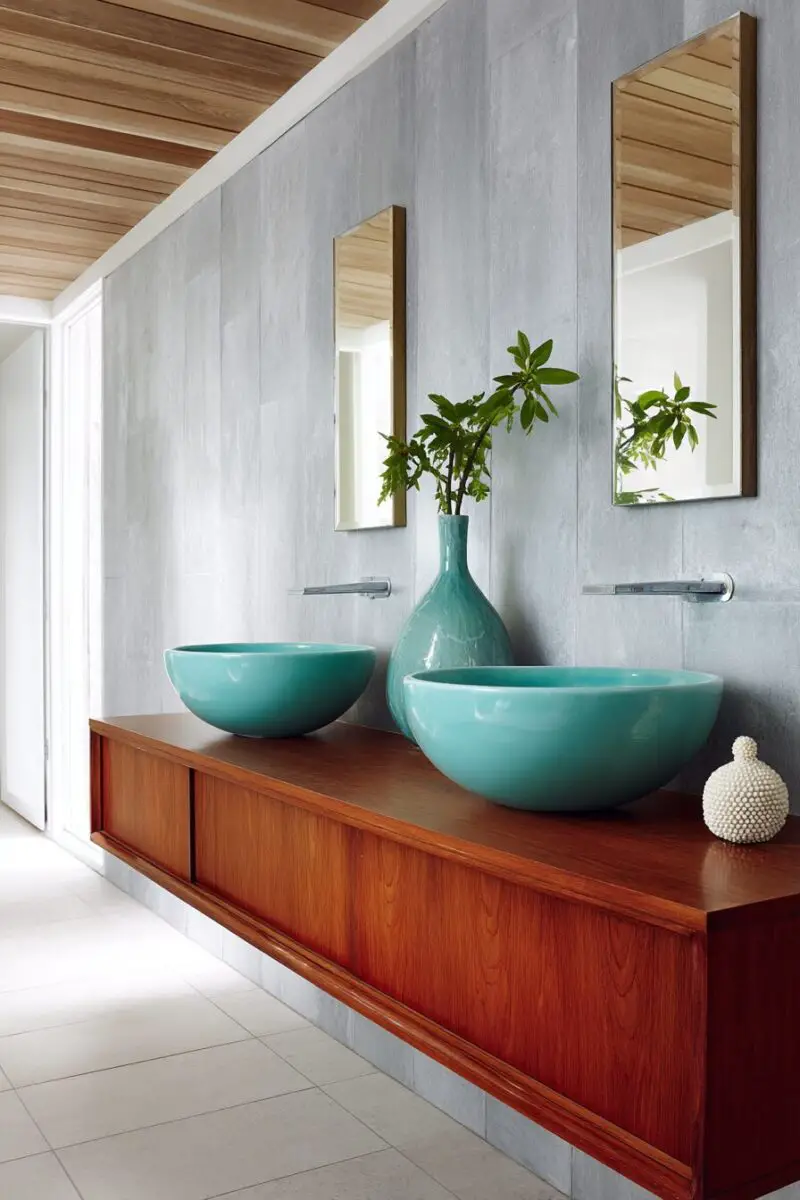

Forget boring builder-grade cabinets – retro bathrooms demand vanities with personality and history.
One of the most delightful trends in retro bathroom design is repurposing antique furniture pieces like dressers, sideboards, or even old sewing machines as unique bathroom vanities.
These conversation-starting pieces bring warmth, texture, and unexpected character to what’s typically the most utilitarian room in the house.
For authentic mid-century vibes, look for vanities with tapered legs, minimal hardware, and clean lines – typically in warm wood tones like teak or walnut.
Earlier 20th century styles might feature more ornate details, like curved legs, carved accents, and painted finishes in cream or pastel colors.
The contrast between old-world cabinetry and sleek, modern vessel sinks creates a perfect tension between vintage and contemporary elements.
You can often find these potential vanities at thrift stores, estate sales, or online marketplaces for a fraction of what you’d pay for new bathroom furniture.
Retrofitting an antique piece requires some professional help to accommodate plumbing and protect the wood from moisture, but the unique result is worth the extra effort.
For a more streamlined retro look, seek out authentic mid-century bathroom vanities with their characteristic floating appearance and minimal footprint.
Chrome hardware and leg details were particularly popular in the 1950s and 60s, adding a touch of space-age optimism to bathroom design.
Don’t forget the mirrors – pair your vintage vanity with an equally characterful mirror, whether it’s a sunburst design, a medicine cabinet with chrome details, or a simple round mirror suspended on a fabric strap.
The beauty of vintage vanities is that they often provide more interesting storage solutions than standard bathroom cabinets, with various drawers and compartments perfectly sized for bathroom essentials.
✨Click to Get My 101 FREE Designer Room Ideas
Statement-Making Tile Patterns and Colors
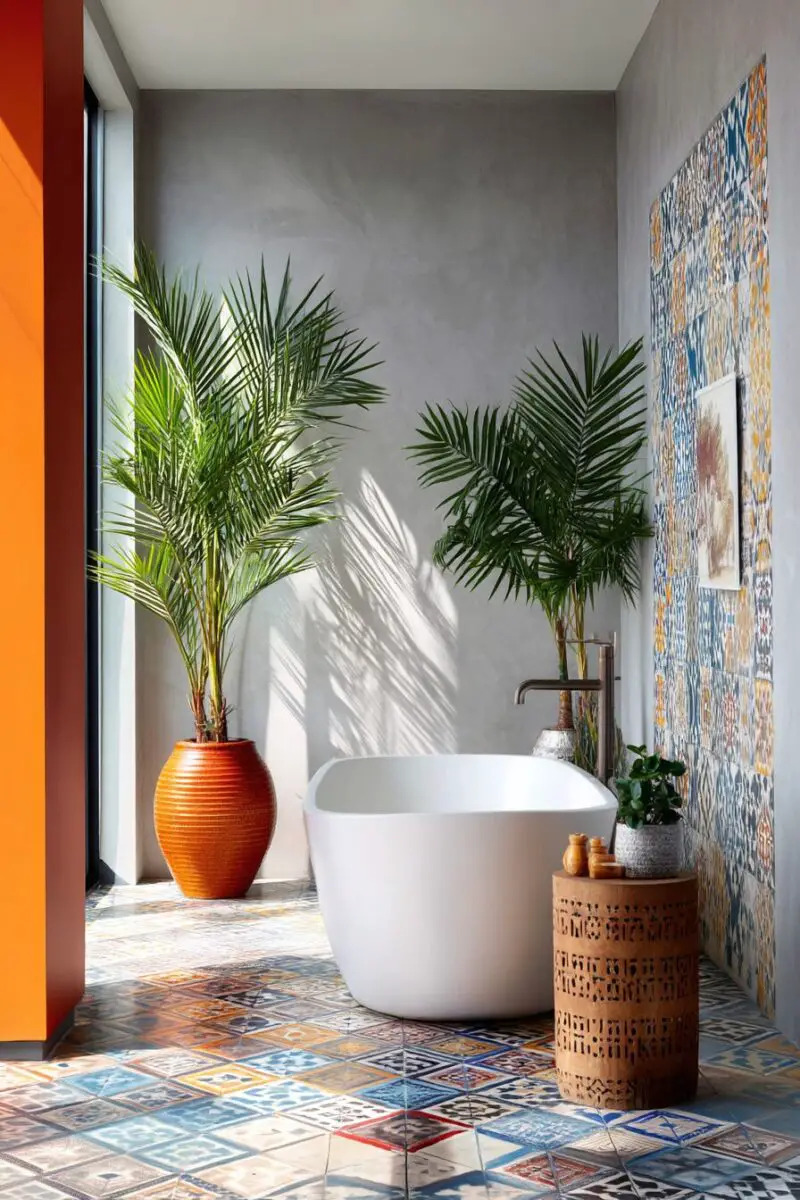

Retro bathrooms weren’t shy about making bold statements with distinctive tile work that today’s homeowners are rediscovering with enthusiasm.
The quintessential 1950s bathroom often featured 4×4 square tiles in candy colors, frequently with contrasting trim pieces known as “liner tiles” that created frames around the walls.
You might also remember the distinctive bullnose edge tiles that created smooth, rounded corners instead of sharp edges – a detail that’s making a major comeback.
Subway tiles have never really gone out of style, but setting them in distinctive patterns like herringbone or vertical stacks instead of the traditional offset brick pattern gives them fresh retro energy.
Bold geometric tile patterns, especially on shower walls or as floor insets, capture the playful optimism of mid-century design.
The 1930s Art Deco bathroom featured distinctive hex tiles, often in complex black and white patterns that are enjoying renewed popularity today.
Pink and black tile combinations, once considered hopelessly dated, are now coveted by home renovators looking to create authentic vintage bathrooms.
For maximum impact, consider tiling all the way to the ceiling – a common practice in mid-century bathrooms that creates a seamless, enveloping effect.
Multicolor tile “borders” running horizontally across bathroom walls at chair rail height add instant period character.
Don’t forget the floor – intricate mosaic patterns using penny rounds, basket weave, or hexagonal tiles with flower motifs were bathroom staples for decades.
While reproduction tiles are widely available, salvage yards and specialty retailers sometimes offer authentic vintage tiles rescued from old buildings slated for demolition.
The contrast of glossy ceramic tiles against more matte elements creates the depth and textural interest that makes retro bathrooms so visually appealing.
Modern manufacturing techniques mean you can now get the retro look with improved durability and easier maintenance than the original materials offered.
Wallpaper That Wows
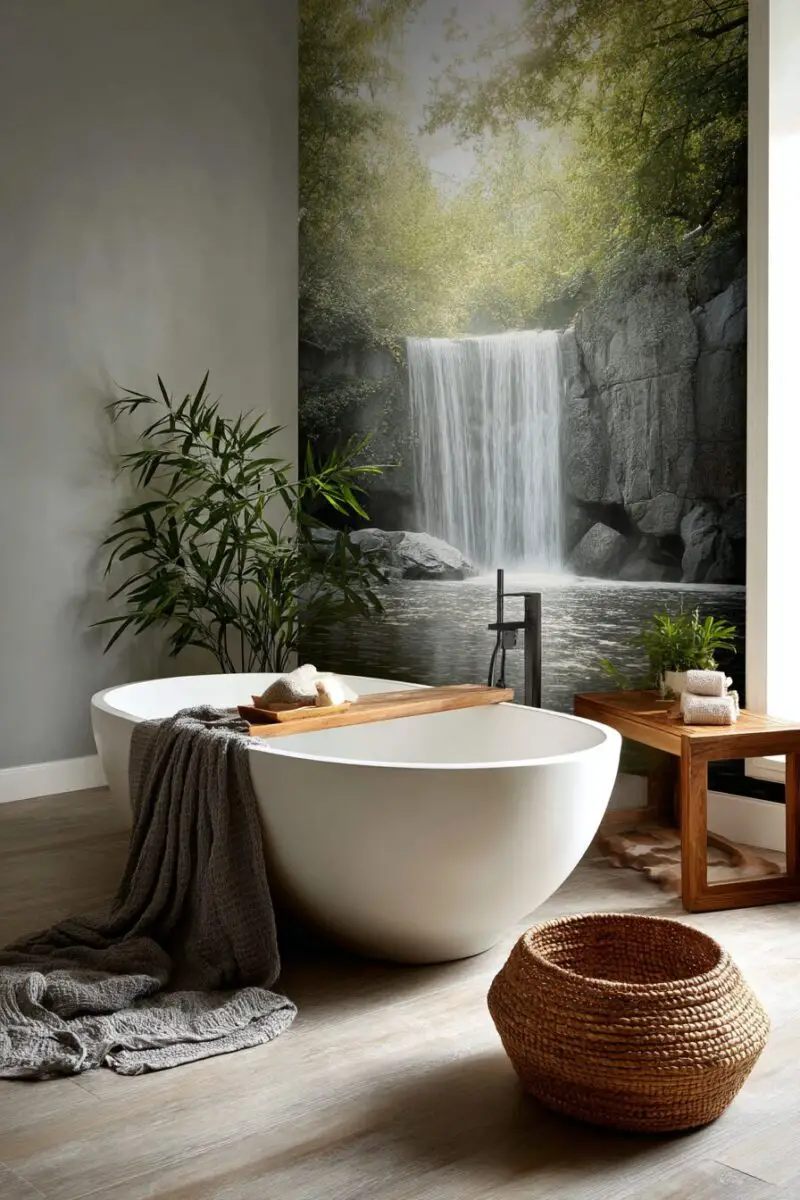
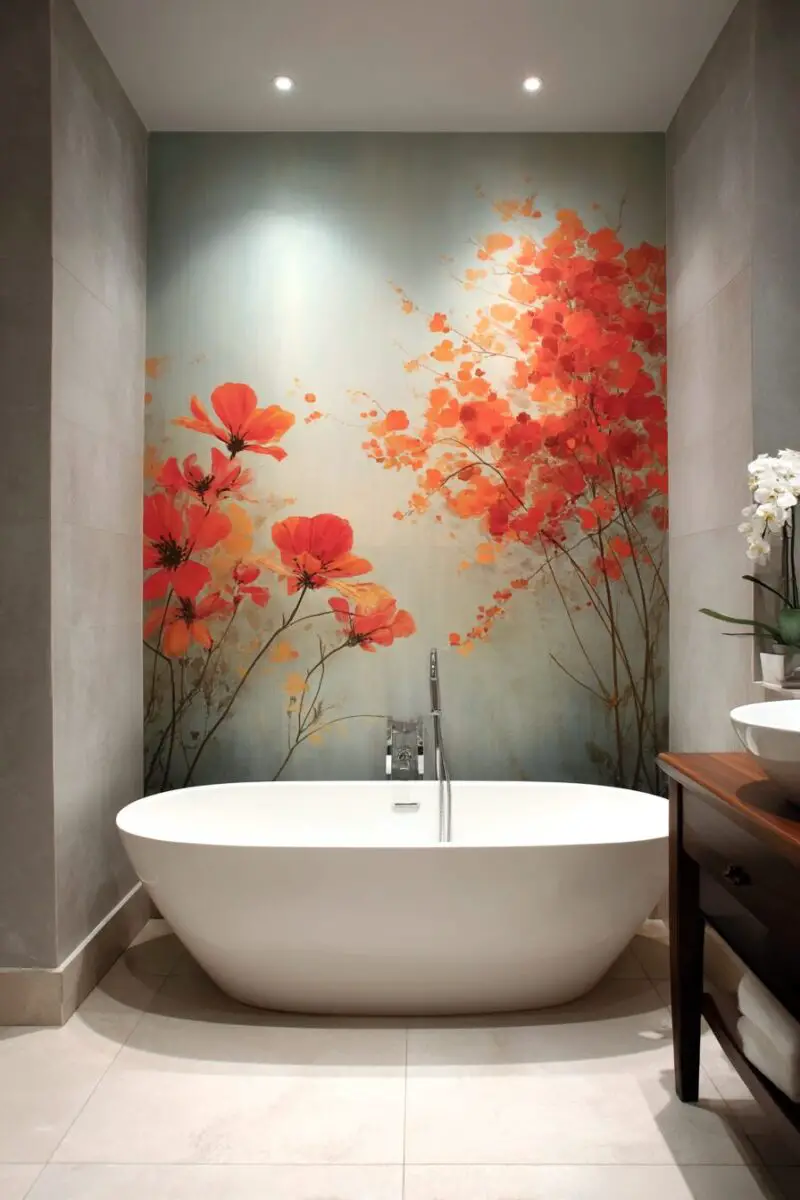
Bathroom wallpaper has made an incredible comeback, and nowhere does it shine more brilliantly than in retro-inspired spaces where bold patterns reign supreme.
Unlike the flimsy wallpapers of yesteryear, today’s vinyl and non-woven options are specifically designed to withstand bathroom humidity while delivering major style points.
Geometric patterns were huge in mid-century bathrooms – think starburst designs, boomerangs, atomic dots, and abstract shapes in contrasting colors.
Floral patterns transcend specific decades – from delicate 1930s blooms to bold 1960s flower power motifs – and immediately establish a vintage vibe.
Metallic elements, especially gold and silver, appeared frequently in 1920s and 1930s bathroom wallpapers, adding glamour and reflecting light in these often small spaces.
For authentic 1950s charm, look for novelty prints featuring household items, stylized figures, or kitschy themes like tropical scenes or maritime motifs.
You don’t have to wallpaper the entire bathroom – even a single accent wall behind the vanity can deliver major retro personality.
Textured wallpapers like grasscloth or embossed vinyl add another dimension to your bathroom while staying true to vintage aesthetics.
Many classic wallpaper designs from companies like Sanderson and Cole & Son have been in continuous production for decades, meaning you can find authentic patterns that have adorned bathrooms since the early 20th century.
For maximum impact, coordinate your wallpaper with solid-colored tiles in complementary hues.
The juxtaposition of busy wallpaper with sleek, minimalist fixtures creates the perfect balance of playful and sophisticated.
Don’t forget the ceiling – especially in powder rooms, an unexpected wallpapered ceiling was a delightful surprise in many mid-century homes.
If commitment issues are holding you back, removable wallpaper offers a lower-risk way to experiment with bold retro patterns.
Lighting That Sets the Mood
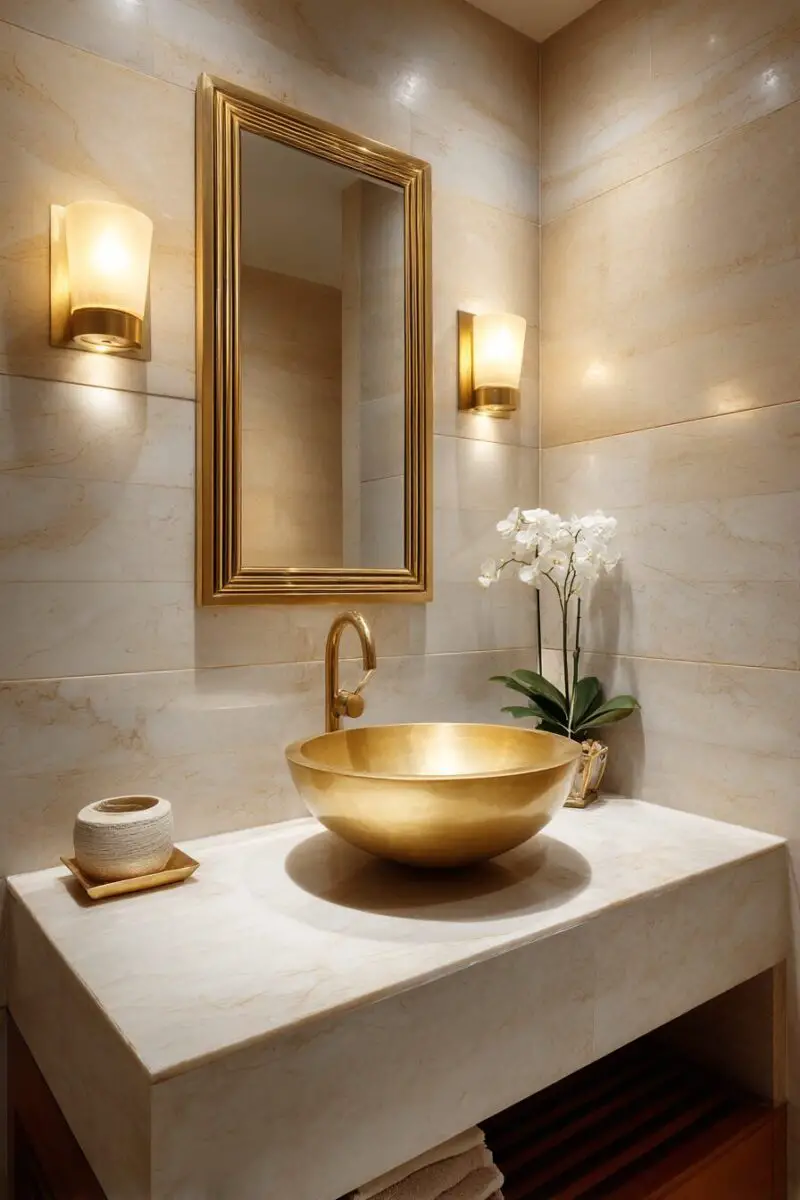
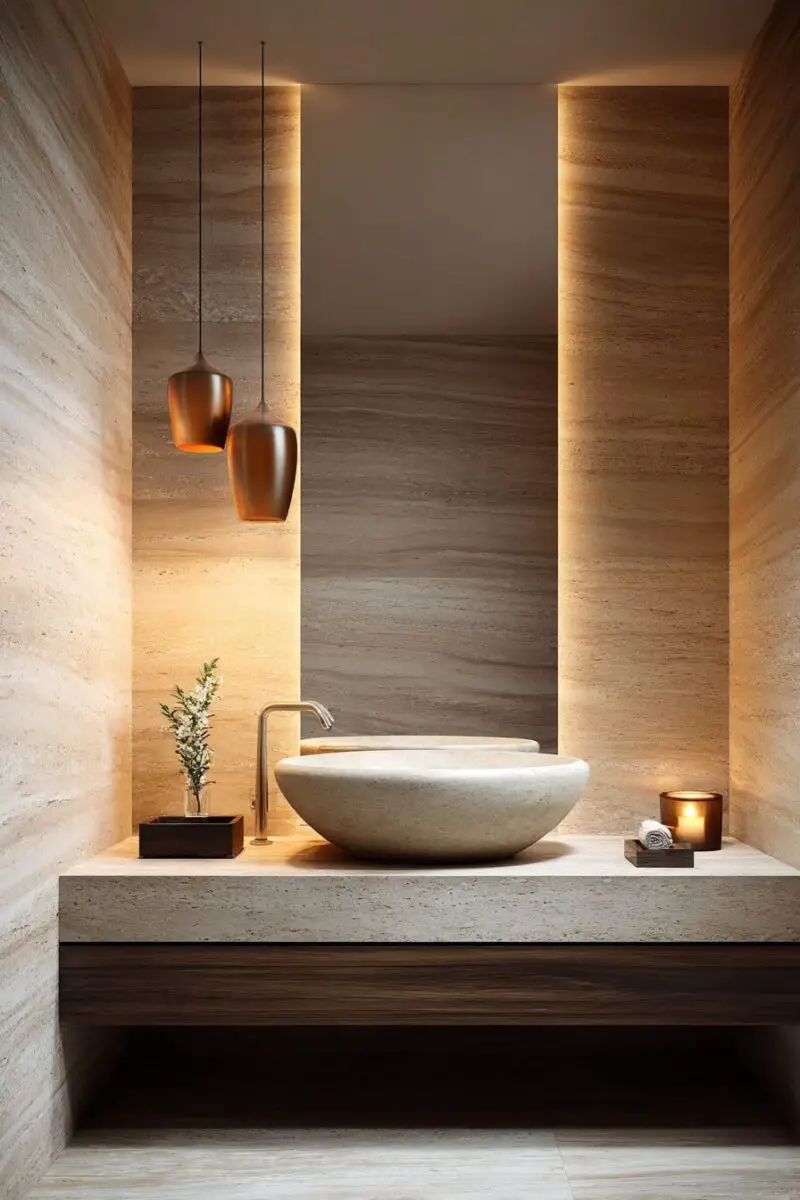
Lighting in retro bathrooms wasn’t an afterthought – it was an integral design element that combined functionality with distinctive period style.
The Hollywood-style vanity lights featuring exposed globe bulbs running above or alongside mirrors defined the glamorous bathroom aesthetic of the 1930s and 40s.
These theatrical lighting setups not only looked impressive but provided the ideal illumination for makeup application and grooming tasks.
For authentic mid-century modern bathrooms, look for sputnik-style fixtures with multiple arms extending from a central point, or streamlined sconces with cylindrical glass shades.
Milk glass fixtures – those white glass shades with a slightly translucent quality – were bathroom staples from the 1930s through the 1960s and cast a flattering, diffused light.
Chrome and brass were the dominant metallic finishes, though by the 1970s, warmer tones like copper and bronze had entered the bathroom lighting scene.
Don’t overlook the charm of retro ceiling fixtures – particularly those charming flush-mount options with textured or patterned glass that cast interesting shadows on the ceiling.
Proper placement is key – vintage bathrooms typically featured lighting at the vanity, overhead, and sometimes even a decorative fixture near the tub area for layered illumination.
For authentic vintage appeal with modern convenience, look for LED bulbs designed to mimic the warm glow of old incandescent lighting rather than harsh, cool-toned options.
Pendant lights weren’t common in older bathrooms due to safety regulations, but if your ceiling height allows, a strategically placed pendant can add unexpected retro flair to a modern bathroom.
Many lighting manufacturers offer reproductions of classic bathroom fixtures, allowing you to capture the vintage look without the wiring headaches of genuine antique lights.
Remember that older bathrooms typically had more modest lighting compared to today’s bathroom light shows – embracing a slightly softer illumination level can enhance the authentic retro feel.
For true period authenticity, consider the style transition points – Art Deco influences dominated the 1920s-30s, while streamlined simplicity characterized the 1950s-60s before the more decorative 1970s approaches.
Fixtures and Hardware with Personality

The faucets, handles, towel bars and other hardware elements might seem like small details, but they’re actually the jewelry of your retro bathroom – essential finishing touches that define the era you’re channeling.
Cross handles rather than single-lever controls were standard in vintage bathrooms, instantly signaling a bygone era of bathroom design.
For pre-1960s authenticity, look for separate hot and cold faucets rather than the mixed temperature faucets we take for granted today.
Porcelain handles with “hot” and “cold” embossed on them add charming detail that modern minimalist fixtures lack.
Chrome dominated bathroom metal finishes for decades, offering a bright, mirror-like shine that reflected the optimism and cleanliness-obsession of the post-war era.
Brass hardware, often with an unlacquered finish that develops a living patina over time, creates a warmer, more traditional bathroom feeling appropriate for early 20th century styles.
Distinctive shapes like cross handles, star-shaped controls, or lever handles with porcelain insets immediately transport your bathroom back several decades.
Don’t overlook shower details – exposed pipe shower systems with rain showerheads and diverter valves were common before built-in systems became standard, and now they’re coveted for their architectural presence.
Towel bars with integrated soap dishes or other multi-functional bath accessories showcase the clever space utilization of older bathroom designs.
Glass shelves supported by chrome brackets were bathroom staples that combined practicality with visual lightness.
For true vintage authenticity, hunt down original bathroom accessories at architectural salvage yards or restoration-focused retailers who specialize in period-appropriate pieces.
Even something as simple as switching out standard toilet flush handles for chain-pull mechanisms or decorative porcelain levers adds to the immersive vintage experience.
The beauty of focusing on hardware details is that they can be updated relatively inexpensively compared to major bathroom elements like tile and fixtures.
✨Click to Get My 101 FREE Designer Room Ideas
Storage Solutions with Vintage Charm
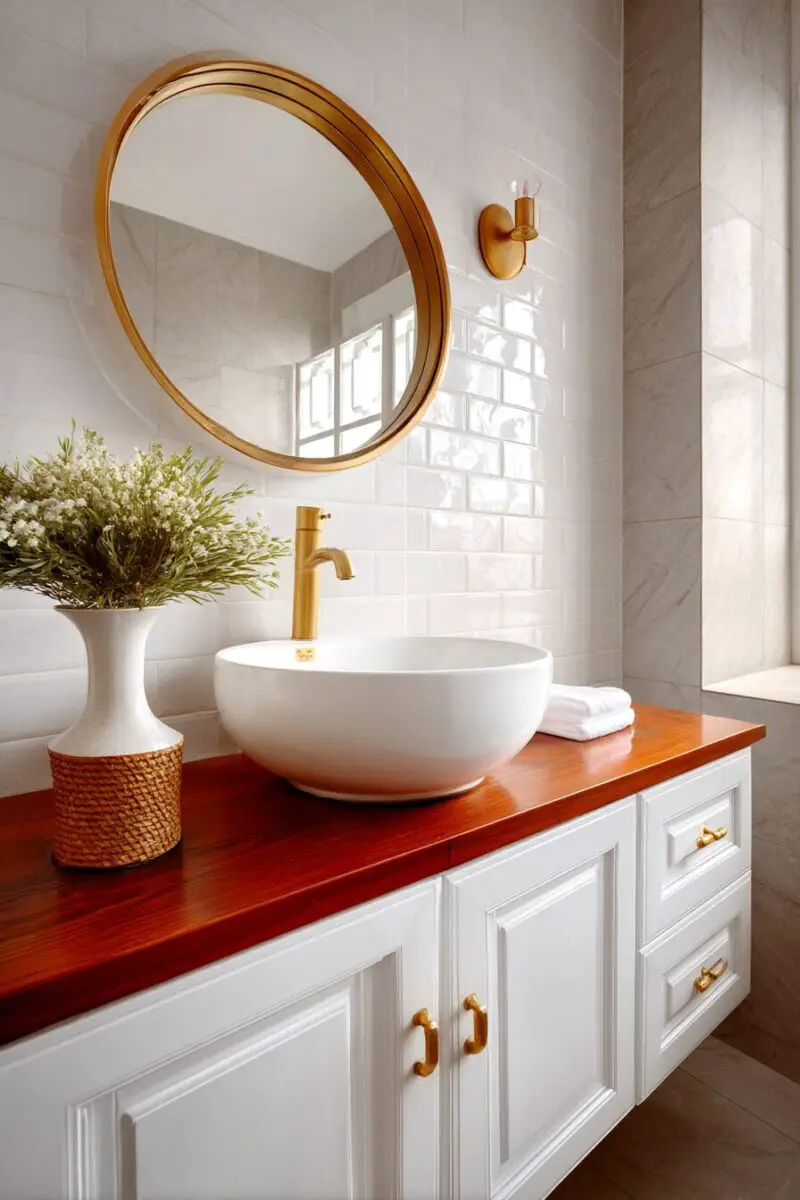
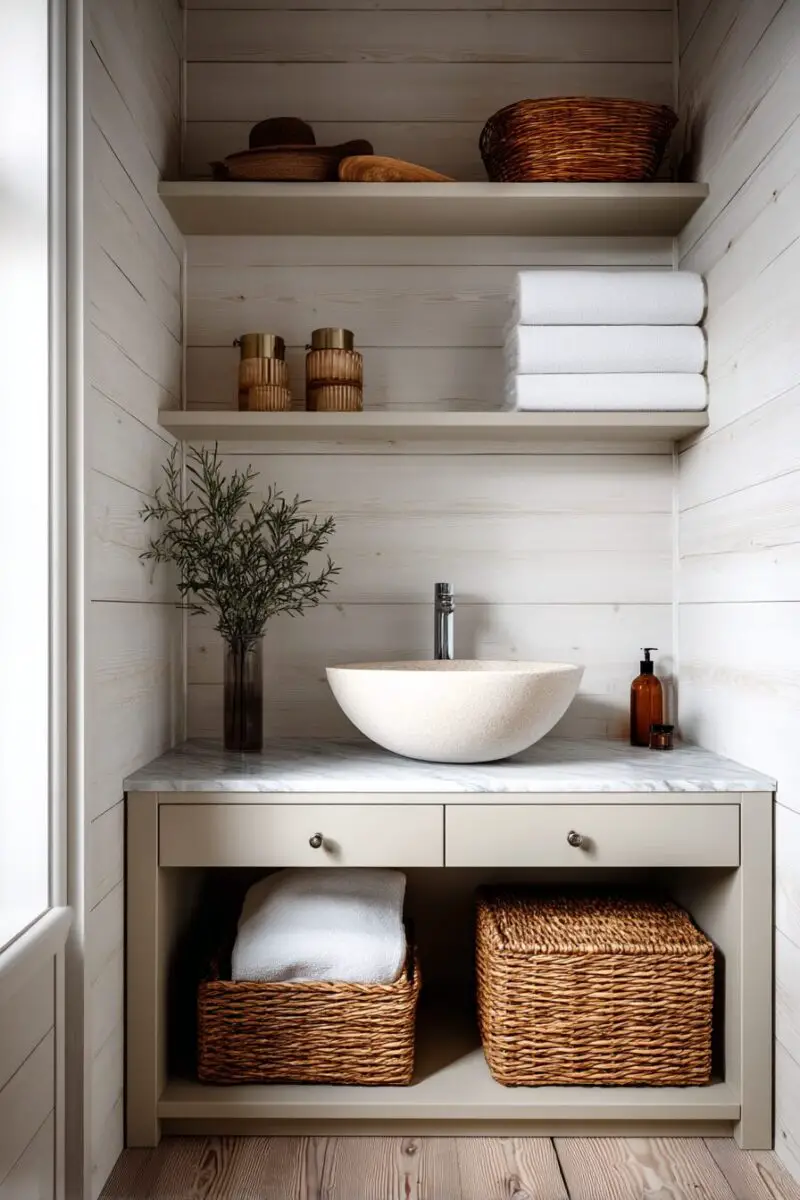
Retro bathrooms approached storage differently than today’s built-in cabinet wonderlands, often relying on freestanding pieces and clever wall-mounted solutions that added character along with functionality.
Medicine cabinets were statement pieces rather than hidden storage, often featuring distinctive frames, specialized lighting, or even unusual shapes like ovals or hexagons.
The classic recessed medicine cabinet with a mirrored door was a bathroom standard for decades, though more decorative surface-mounted versions were also popular.
Open shelving displayed bathroom essentials rather than hiding them away – often on glass or chrome shelves that maintained visual lightness in small spaces.
Freestanding bathroom étagères (those toilet-straddling shelving units) were mid-century storage workhorses that are making a major comeback for their combination of practicality and personality.
Built-in storage niches for soap and toiletries were often incorporated into tile work, sometimes with decorative arch tops or contrasting tile borders.
Wicker and rattan storage pieces added textural warmth to the sometimes cold surfaces of bathrooms – hampers, magazine racks, and small storage cubes were common.
Wall-mounted toothbrush holders, soap dishes, and cups were typically built into the wall rather than sitting on countertops, freeing up limited surface space.
Glass jars with decorative lids were displayed proudly on vanities, holding cotton balls, bath salts, and other toiletries that are now typically hidden away.
For authentic 1950s charm, look for tension-pole shower caddies that extend from floor to ceiling, adding storage without requiring wall installation.
Towel storage often relied on multiple towel bars and hooks rather than linen closets, turning necessities into decorative elements.
Under-sink curtains rather than cabinet doors were common in many vintage vanities, adding fabric softness and pattern to bathroom design.
The beauty of vintage bathroom storage is how it combines practicality with personality – each piece contributing to the overall aesthetic rather than trying to disappear.
Accessorizing with Retro Flair

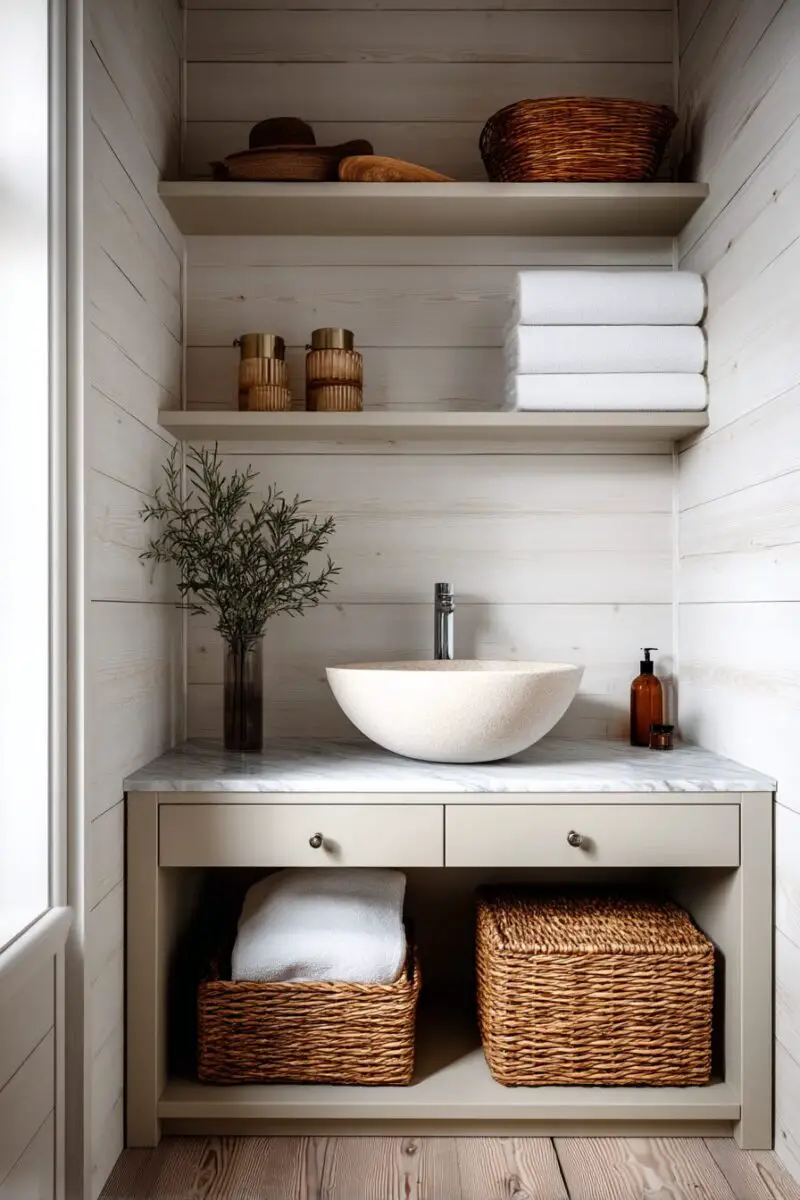
The final layer of retro bathroom magic comes through carefully chosen accessories that reinforce your chosen era while adding personality and functional touches.
Vintage bath scales – particularly those charming dial versions with built-in height measures – make both functional and decorative statements.
Real cloth hand towels with decorative edging or embroidery details instantly elevate your bathroom from basic to special-occasion ready.
Glass and ceramic soap dishes, particularly those in colors that coordinate with your tile, were bathroom staples that have far more character than today’s plastic pump dispensers.
Matching bathroom sets including tissue holders, cups, and waste baskets in coordinating colors and patterns were popular from the 1930s through the 1970s.
Wall clocks designed specifically for bathroom use were common features, usually in water-resistant materials and decorative styles that complemented the room’s aesthetic.
Strategic use of plants, particularly in decorative planters, connects to the mid-century love of bringing the outdoors in.
Framed vintage advertisements for beauty products or bath-related items make perfect bathroom wall art that reinforces the retro theme.
For authentic 1950s styling, look for bathroom accessories in coordinating pastel shades with atomic or starburst motifs.
Mirror frames offer another opportunity for period-specific detailing – whether it’s an ornate gilt frame for a 1920s look or a streamlined wood frame for mid-century modern vibes.
Shower curtains provide major design impact for minimal investment – look for patterns specific to your chosen era or solid colors with distinctive textural elements.
Old-school details like robe hooks, toilet paper holders with covers, and decorative switch plates are small touches that contribute to the overall authenticity.
The beauty of accessorizing is flexibility – these smaller elements can be easily swapped out as your taste evolves or when you want seasonal refreshes without major renovation.
Remember that in authentic vintage bathrooms, functionality never took a backseat to style – each decorative element typically served a practical purpose as well.
Retro bathrooms tap into something deeper than just design trends – they connect to nostalgic memories and simpler times while standing out from today’s often sterile, all-white bathroom aesthetic.
Remember that the most successful retro bathrooms don’t feel like museum exhibits – they balance vintage charm with modern functionality, creating spaces that honor the past while meeting today’s needs.


